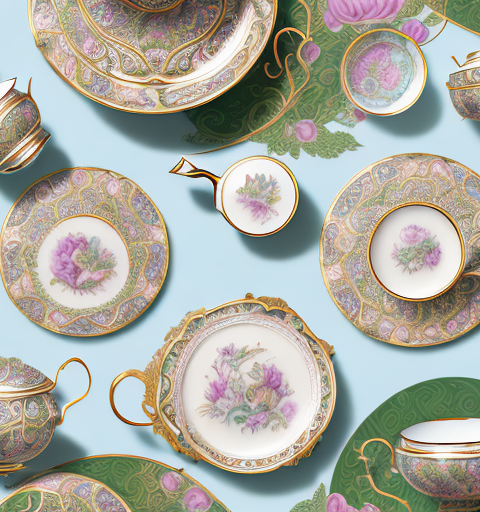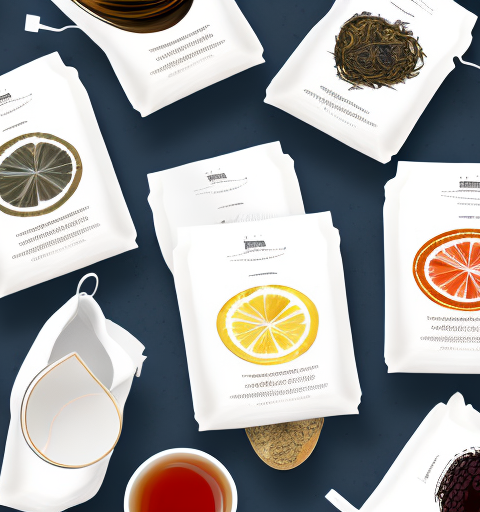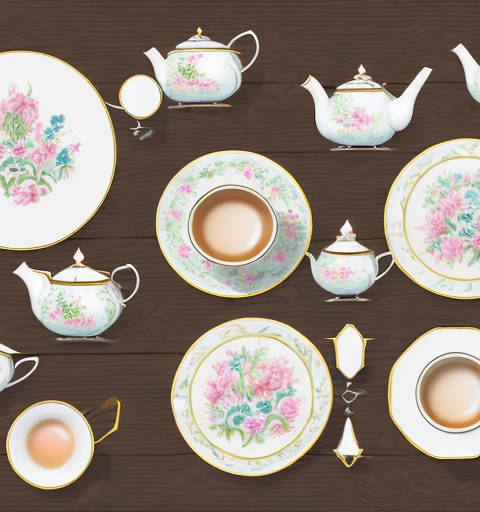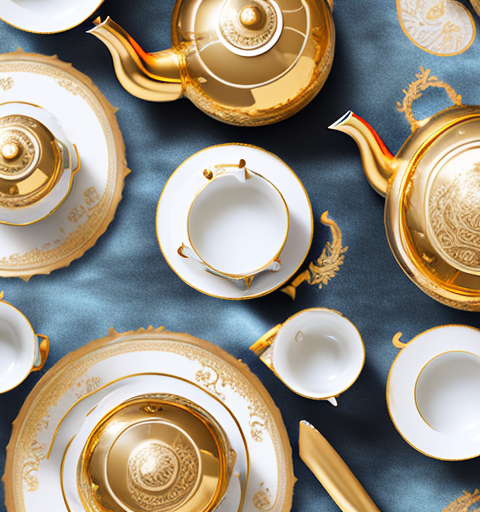Tea stains on ceramic handles can be unsightly and difficult to remove. In this article, we will explore the various causes of tea stains on ceramic handles, the importance of maintaining a clean teapot handle, essential tools and materials for removing tea stains, and provide a comprehensive step-by-step guide for effectively removing tea stains from a ceramic teapot handle. We will also discuss homemade remedies, commercial cleaning products, tips for preventing tea stains, the role of heat-resistance in choosing a teapot handle, common mistakes to avoid, and the frequency of cleaning to prevent tea stains. Furthermore, we will provide expert advice on maintaining the longevity and appearance of ceramic teapot handles, explore alternative materials that are more resistant to tea stains, delve into the science behind tea staining, troubleshoot stubborn tea stains, highlight the benefits of using natural cleaning methods, and address frequently asked questions about removing tea stains from heat-resistant ceramic teapot handles.
Understanding the causes of tea stains on ceramic handles
Tea stains on ceramic handles can be caused by various factors. One common cause is the tannins present in tea, which tend to stick to surfaces and leave behind stains. Another cause is insufficient cleaning or negligence in maintaining the teapot handle. Additionally, hard water can contribute to tea stains, as the mineral deposits can build up over time. Understanding these causes is essential in effectively tackling tea stains on ceramic handles.
Furthermore, the temperature of the tea can also play a role in the formation of stains on ceramic handles. When hot tea comes into contact with a cold ceramic handle, it can cause thermal shock, leading to cracks or small fractures in the surface. These cracks can then trap tea particles and tannins, resulting in stubborn stains that are difficult to remove. Therefore, it is important to handle ceramic teapots with care and avoid sudden temperature changes to prevent the formation of tea stains on the handles.
The importance of maintaining a clean teapot handle
Keeping a clean teapot handle is crucial not only for aesthetic purposes but also for hygiene and functionality. A dirty handle can harbor bacteria and affect the taste of your tea. Furthermore, a clean handle ensures a comfortable grip and prevents accidents caused by slippery surfaces. Regular cleaning and maintenance of your teapot handle are essential to maintain its cleanliness and prolong its lifespan.
In addition to the hygiene and functionality benefits, maintaining a clean teapot handle also helps to preserve the quality of your tea. When the handle is dirty, it can transfer unwanted flavors and odors to your tea, compromising its taste. By keeping the handle clean, you can ensure that your tea retains its original flavors and aromas.
Another reason to prioritize the cleanliness of your teapot handle is to prevent the buildup of mineral deposits. Over time, minerals from the water used to brew tea can accumulate on the handle, creating a rough and gritty texture. This not only affects the overall appearance of the teapot but can also make it uncomfortable to hold. Regular cleaning and gentle scrubbing can help remove these deposits and maintain a smooth handle surface.
Essential tools and materials for removing tea stains from ceramic handles
To effectively remove tea stains from ceramic handles, you will need a few essential tools and materials. First and foremost, a mild detergent or dish soap is essential for cleaning the handle. Additionally, a soft sponge or cloth should be used to gently scrub the stained area. For tougher stains, a non-abrasive brush can be used. Finally, a solution of vinegar and water or a specialized ceramic cleaner can be employed for stubborn stains.
Another important tool to have when removing tea stains from ceramic handles is a toothbrush. The small bristles of a toothbrush can reach into crevices and corners that may be difficult to clean with a sponge or cloth. It is recommended to use a separate toothbrush specifically for cleaning purposes, rather than using one that is used for oral hygiene.
In addition to the tools mentioned above, it is also helpful to have a microfiber cloth on hand. Microfiber cloths are known for their ability to effectively remove stains and dirt without leaving behind lint or scratches. When using a microfiber cloth, it is important to gently wipe the ceramic handle in a circular motion to avoid any potential damage.
Step-by-step guide to removing tea stains from a ceramic teapot handle
Follow these steps to remove tea stains from a ceramic teapot handle:
- Prepare a solution of warm water and mild detergent in a basin or sink.
- Submerge the teapot handle in the soapy water and let it soak for a few minutes.
- Gently scrub the stained area with a soft sponge or cloth, applying light pressure.
- If the stain persists, create a paste of baking soda and water and apply it to the stained area.
- Leave the paste on the handle for a few minutes, then scrub gently.
- Rinse the handle thoroughly with clean water to remove any residue.
- If the stain is still visible, create a mixture of vinegar and water and apply it to the stained area.
- Allow the mixture to sit on the handle for a few minutes, then gently scrub.
- Rinse the handle once again to remove any remaining residue.
- Dry the handle with a soft towel to prevent water spots.
It is important to note that the effectiveness of these stain removal methods may vary depending on the severity and age of the tea stains. For stubborn or older stains, it may be necessary to repeat the steps or try alternative cleaning solutions. Additionally, always test any cleaning solution on a small, inconspicuous area of the teapot handle before applying it to the entire stained area to ensure it does not cause any damage or discoloration.
Effective homemade remedies for tackling stubborn tea stains on ceramic handles
Homemade remedies can be an effective and budget-friendly solution for tackling stubborn tea stains on ceramic handles. One popular homemade remedy is a mixture of baking soda and water, which works as a gentle abrasive to remove stains. Another option is using a solution of vinegar and water, as vinegar acts as a natural cleaning agent. Applying these remedies and following the previously mentioned step-by-step guide can help remove even the most stubborn tea stains.
Exploring commercial cleaning products specifically designed for tea stain removal on ceramic surfaces
If homemade remedies do not yield satisfactory results, exploring commercial cleaning products specifically designed for tea stain removal on ceramic surfaces can be a viable option. Many manufacturers offer specialized cleaners formulated to effectively remove tea stains without damaging ceramic handles. These products often come with detailed instructions and should be used according to the manufacturer’s recommendations. When using commercial cleaning products, it is important to follow the safety guidelines provided and ensure proper ventilation.
One popular type of commercial cleaning product for tea stain removal on ceramic surfaces is a stain remover spray. These sprays are designed to be sprayed directly onto the stained area and left to sit for a few minutes before being wiped away with a clean cloth or sponge. They are often effective at breaking down and removing stubborn tea stains.
Another option to consider is a cleaning paste or gel specifically formulated for tea stain removal. These products are typically applied to the stained area and left to sit for a longer period of time, allowing the cleaning agents to penetrate and dissolve the tea stains. After the recommended time has passed, the paste or gel can be rinsed off with water, revealing a clean and stain-free ceramic surface.
Tips and tricks for preventing tea stains from forming on ceramic teapot handles in the first place
Prevention is always better than cure when it comes to tea stains on ceramic teapot handles. Here are some tips and tricks to prevent tea stains from forming:
- Regularly clean and dry your teapot handle after each use.
- Avoid leaving tea stains to sit for extended periods on the handle.
- Use a teapot with a heat-resistant grip that is easy to clean.
- Consider using teapot handles made from alternative materials resistant to tea stains.
- Use filtered or distilled water to reduce mineral deposits and hard water stains.
- Wipe the handle with a damp cloth immediately after use to remove any tea residue.
The role of heat-resistance in choosing a teapot with a handle that is easy to clean
When selecting a teapot with a handle that is easy to clean, the heat-resistance of the material should be considered. Ceramic handles that are heat-resistant are generally more suitable for tea brewing and easier to clean. Heat-resistant handles can withstand hot water without cracking or warping, making them less likely to develop cracks and crevices where tea stains can accumulate. Choosing a teapot with a heat-resistant grip is a key factor in preventing and managing tea stains on ceramic handles.
Common mistakes to avoid when trying to remove tea stains from ceramic teapot handles
While removing tea stains from ceramic teapot handles, it is important to avoid common mistakes that can hinder the cleaning process. Some of these mistakes include:
- Using harsh or abrasive cleaners that can damage the ceramic surface.
- Applying excessive force or scrubbing too vigorously, which can cause scratches or chip the handle.
- Using abrasive brushes or scouring pads that can leave marks on the ceramic.
- Leaving cleaning products on the handle for prolonged periods, which can cause discoloration.
- Not rinsing the handle thoroughly after cleaning, which can leave behind residue.
How often should you clean your teapot handle to prevent tea stains?
Cleaning your teapot handle regularly is essential to prevent tea stains from forming. It is recommended to clean the handle after each use to remove any tea residue. By doing so, you reduce the buildup of tannins and mineral deposits, ensuring that your teapot handle remains clean and stain-free. If you notice any discoloration or staining, it is best to address it as soon as possible to prevent it from becoming more stubborn and difficult to remove.
Expert advice on maintaining the longevity and appearance of ceramic teapot handles
To maintain the longevity and appearance of ceramic teapot handles, it is important to follow expert advice. Here are some tips:
- Handle your teapot with care to avoid dropping or mishandling it, which can cause cracks or chips in the handle.
- Regularly clean and dry the handle to prevent the accumulation of tea stains and mineral deposits.
- Avoid exposing your teapot handle to extreme temperatures, as sudden changes can cause the ceramic to crack.
- Store your teapot in a cool, dry place away from direct sunlight to prevent discoloration and fading of the handle.
- If your teapot handle becomes severely stained or damaged, consider consulting a professional for restoration or replacement.
Exploring alternative materials for teapot handles that are more resistant to tea stains
If you find that ceramic teapot handles are prone to tea stains, exploring alternative materials can be a solution. Materials such as heat-resistant plastics, stainless steel, or wood can be considered as alternatives. These materials are generally more resistant to tea stains and easier to clean. However, it is important to ensure that the alternative material is food-safe and can withstand the heat required for brewing tea.
Understanding the science behind tea staining and its impact on ceramic surfaces
Tea staining on ceramic surfaces is a result of the chemical properties of tea and its interaction with the ceramic material. Tea contains tannins, which are a type of natural plant pigment. These tannins can bind to the ceramic surface, resulting in discoloration and staining. Over time, exposure to tea can cause the stains to become more pronounced and difficult to remove. The impact of tea staining on ceramic surfaces is not only aesthetic but can also affect the functionality and hygiene of teapot handles.
Troubleshooting tips for dealing with particularly stubborn tea stains on ceramic handles
If you encounter particularly stubborn tea stains on ceramic handles, here are some troubleshooting tips to help you overcome the challenge:
- Repeat the cleaning process using a specialized ceramic cleaner or vinegar solution.
- Let the cleaning solution soak on the handle for an extended period before scrubbing.
- Gently scrub the stained area with a non-abrasive brush to dislodge the stubborn stain.
- Incorporate the use of a commercial stain remover designed for ceramic surfaces.
- Consult a professional ceramic restorer for recommendations on tackling stubborn tea stains.
The benefits of using natural cleaning methods for removing tea stains from ceramic surfaces
There are several benefits to using natural cleaning methods for removing tea stains from ceramic surfaces. Firstly, natural cleaning methods are generally safer for both the user and the environment, as they do not contain harsh chemicals. Secondly, natural cleaners like vinegar and baking soda are readily available and cost-effective alternatives to commercial cleaning products. Furthermore, natural cleaning methods are often gentle on ceramic surfaces, reducing the risk of damage or discoloration. By using natural cleaning methods, you can effectively remove tea stains while minimizing your environmental impact.
Frequently asked questions about removing tea stains from heat-resistant ceramic teapot handles
Here are some frequently asked questions about removing tea stains from heat-resistant ceramic teapot handles:
- Can I use bleach to remove tea stains from ceramic handles?
- Can I use a dishwasher to clean tea stains from ceramic teapot handles?
- Are commercial ceramic cleaning products safe to use on heat-resistant teapot handles?
- Why are tea stains more visible on light-colored ceramic handles?
- Can tea stains on ceramic handles be completely removed?
Bleach is not recommended for removing tea stains from ceramic handles, as it can damage the ceramic surface and cause discoloration. It is best to use mild detergents, specialized ceramic cleaners, or natural cleaning methods.
While dishwashers are generally safe for cleaning ceramic teapot handles, they may not be as effective in removing tea stains. It is best to hand wash the handle using the step-by-step guide mentioned earlier for optimal stain removal.
Yes, commercial ceramic cleaning products that are specifically designed for removing tea stains from ceramic surfaces are generally safe to use on heat-resistant teapot handles. However, it is essential to follow the instructions provided by the manufacturer and exercise caution to prevent any potential damage.
Tea stains appear more visible on light-colored ceramic handles due to the contrast between the dark tannin stains and the lighter background. Light-colored ceramics also tend to show discoloration more prominently, highlighting the presence of tea stains.
While it is often possible to remove tea stains from ceramic handles, there may be instances where the stain is persistent or has caused permanent discoloration. In such cases, thorough cleaning, alternative cleaning methods, or consulting a professional restorer may be necessary.
By following the tips, techniques, and advice provided in this article, you can effectively remove tea stains from the ceramic handle of your teapot with a heat-resistant grip, ensuring it remains clean, hygienic, and visually appealing for many tea-filled moments to come.






